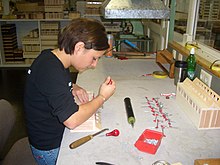Hand-drawn instrument maker
Handzuginstrumentenmacher in Austria harmonica maker called, make musical instruments such as the accordion, but also blown in instruments such as harmonicas here and fix it. They work in workshops or in shops attached to them. They make accordions , bandoneons , harmonica or melodicas from a variety of materials .
The hand-drawn instrument maker works wood, leather, plastics, textiles and metal by hand and by machine and uses these materials to make all kinds of accordions. Up to 2000 individual parts are produced, from the housing, the bellows and the reed blocks to the keyboard.
The profession combines the activities of a metalworker with those of a bookbinder and carpenter . Professional prerequisites are good musical ear, fine craftsmanship and patience.
education
Hand-drawn instrument maker is a recognized training occupation without specialization according to subject or focus. The training period is three years. Training companies are hand-drawn instrument workshops and producers.
General training content
During their training, the apprentices learn to read and use sketches, parts lists, technical documents, plans and work drawings. You can properly select, check and dispose of required and suitable materials and auxiliary materials. After completing their training, they can join components using screws and nuts, as well as soft and hard soldering, gluing, gluing and wood connections. The assembly of components of a hand- pulled instrument such as bass mechanics and switch groups as well as the final assembly and tuning of instruments are also part of the training content .
The apprentices continue to learn to treat surfaces as well as to identify instruments and to distinguish between different keyboard systems and construction methods as well as their sound conception. To carry out the activities, you can set up your workstation at the workbench or machine tool, and also define work steps, work equipment and work methods. You plan and control work processes and assess the work results. They maintain and care for the tools and machines they use.
In addition to new production, the apprentices also learn to repair hand-pulled instruments. To check the result, you can carry out technical and optical final checks. You also create documentation on work processes. Customer-oriented behavior and customer advice are taught in the training.
Training opportunities
After the apprenticeship, there is the possibility of further training to become a master handcrafted instrument maker, industrial master, technician, specialist, assistant (HWK) or expert. In addition, the specialist knowledge can be deepened during or after training in various courses at the vocational training institutions of the chambers of crafts and professional associations.
Similar professions
- Organ builder ( harmonium building is counted as organ building)
Other names
The official name of this apprenticeship is hand pull instrument maker, but there are a. still names like: "accordion maker", "accordion maker", "harmonica maker", "accordion skilled worker"
The English job title is: "Maker (m / f) of reed-organ musical instruments"
